Controlled Fission and Superposition of Vector Solitons in an Integrable Model of Two-Component Bose–Einstein Condensates
Abstract
1. Introduction
2. The Model
3. The Lax Pair and Integrability Condition
4. Construction of Multi-Soliton Solutions
4.1. The One-Soliton Solution
4.2. The Two-Soliton Solution
4.3. The Three-Soliton Solution
4.4. The Four-Soliton Solution
5. Dynamics of the Four-Soliton Solution
5.1. General Consideration
5.2. Superposition States of Four Solitons
5.3. Controlled Fission of Four-Soliton States
5.4. Elastic Collision of Four-Soliton States
6. Conclusions
Author Contributions
Funding
Data Availability Statement
Conflicts of Interest
References
- Bose, S.N. Plancks Gesetz und Lichtquantenhypothese. Z. Phys. 1924, 26, 178. [Google Scholar] [CrossRef]
- Einstein, A. Quantentheorie des einatomigen idealen Gases. Sitzber. Kgl. Preuss. Akad. Wiss. 1924, 22, 261. [Google Scholar]
- Anderson, M.H.; Ensher, J.R.; Matthews, M.R.; Wieman, C.E.; Cornell, E.A. Observation of Bose-Einstein condensation in a dilute atomic vapor. Science 1995, 269, 198. [Google Scholar] [CrossRef] [PubMed]
- Davis, K.B.; Mewes, M.-O.; Andrews, M.R.; van Druten, N.J.; Durfee, D.S.; Kurn, D.M.; Ketterle, W. Bose-Einstein Condensation in a Gas of Sodium Atoms. Phys. Rev. Lett. 1995, 75, 3969. [Google Scholar] [CrossRef] [PubMed]
- Bradley, C.C.; Sackett, C.A.; Tollett, J.J.; Hulet, R.G. Evidence of Bose-Einstein condensation in an atomic gas with attractive interactions. Phys. Rev. Lett. 1995, 75, 1687–1690, Erratum in Phys. Rev. Lett. 1997, 79, 1170. [Google Scholar] [CrossRef] [PubMed]
- Strecker, K.E.; Partridge, G.B.; Truscott, A.G.; Hulet, R.G. Formation and propagation of matter-wave soliton trains. Nature 2002, 417, 150. [Google Scholar] [CrossRef] [PubMed]
- Khaykovich, L.; Schreck, F.; Ferrari, G.; Bourdel, T.; Cubizolles, J.; Carr, L.D.; Castin, Y.; Salomon, C. Formation of a matter-wave bright soliton. Science 2002, 296, 1290. [Google Scholar] [CrossRef] [PubMed]
- Burger, S.; Bongs, K.; Dettmer, S.; Ertmer, W.; Sengstock, K.; Sanpera, A.; Shlyapnikov, G.V.; Lewenstein, M. Dark solitons in Bose–Einstein condensates. Phys. Rev. Lett. 1999, 83, 5198. [Google Scholar] [CrossRef]
- Frantzeskakis, D.J. Dark solitons in atomic Bose–Einstein condensates: From theory to experiments. J. Phys. A Math. Theor. 2010, 43, 213001. [Google Scholar] [CrossRef]
- Theocharis, G.; Frantzeskakis, D.J.; Kevrekidis, P.G.; Malomed, B.A.; Kivshar, Y.S. Ring dark solitons and vortex necklaces in Bose–Einstein condensates. Phys. Rev. Lett. 2003, 90, 120403. [Google Scholar] [CrossRef] [PubMed]
- Liang, Z.X.; Zhong, Z.D.; Liu, W.M. Dynamical generation of bright solitons in a quasi-one-dimensional condensate. Phys. Rev. Lett. 2005, 94, 050402. [Google Scholar] [CrossRef] [PubMed]
- Dalfovo, F.; Giorgini, S.; Pitaevskii, L.P.; Stringari, S. Theory of Bose–Einstein condensation in trapped gases. Rev. Mod. Phys. 1999, 71, 463. [Google Scholar] [CrossRef]
- Pethick, C.J.; Smith, H. Bose–Einstein Condensation in Dilute Gases; Cambridge University Press: Cambridge, UK, 2002. [Google Scholar]
- Ho, T.L.; Shenoy, V.B. Binary mixtures of Bose condensates of alkali atoms. Phys. Rev. Lett. 1996, 77, 3276. [Google Scholar] [CrossRef] [PubMed]
- Kasamatsu, K.; Tsubota, M.; Ueda, M. Vortices in multicomponent Bose-Einstein condensates. Int. J. Mod. Phys. B 2005, 19, 1835. [Google Scholar] [CrossRef]
- Kevrekidis, P.G.; Frantzeskakis, D.J.; Carretero-González, R. Emergent Nonlinear Phenomena in Bose-Einstein Condensates: Theory and Experiment; Springer: Berlin/Heidelberg, Germany, 2008. [Google Scholar]
- Stoof, H.T.C.; Gubbels, K.B.; Dickerscheid, D.B.M. Ultracold Quantum Fields; Springer: Dordrecht, The Netherlands, 2009. [Google Scholar]
- Ieda, J.; Miyakawa, T.; Wadati, M. Exact analysis of soliton dynamics in spinor Bose-Einstein condensates. Phys. Rev. Lett. 2004, 93, 194102. [Google Scholar] [CrossRef] [PubMed]
- Alotaibi, M.O.D.; Carr, L.D. Dynamics of dark-bright vector solitons in Bose-Einstein condensates. Phys. Rev. A 2017, 96, 013601. [Google Scholar] [CrossRef]
- He, Z.-M.; Zhu, Q.-Q.; Zho, X. The controlled fission, fusion and collision behavior of two species Bose–Einstein condensates with an optical potential. Z. Naturforschung A 2023, 78, 589. [Google Scholar] [CrossRef]
- Busch, T.; Anglin, J.R. Dark-bright solitons in inhomogeneous Bose-Einstein condensates. Phys. Rev. Lett. 2001, 87, 010401. [Google Scholar] [CrossRef] [PubMed]
- Ohberg, P.; Santos, L. Dark Solitons in a Two-Component Bose-Einstein Condensate. Phys. Rev. Lett. 2001, 86, 2918. [Google Scholar] [CrossRef] [PubMed]
- Kasamatsu, K.; Tsubota, M. Modulation instability and solitary-wave formation in two-component Bose-Einstein condensates. Phys. Rev. A 2006, 74, 013617. [Google Scholar] [CrossRef]
- Dauxois, T.; Peyrard, M. Physics of Solitons; Cambridge University Press: Cambridge, UK, 2006. [Google Scholar]
- Kivshar, Y.S.; Agrawal, G.P. Optical Solitons: From Fibers to Photonic Crystals; Academic Press: San Diego, CA, USA, 2003. [Google Scholar]
- Porsezian, K.; Sundaram, P.S.; Mahalingam, A. Coupled higher-order nonlinear Schrödinger equations in nonlinear optics: Painlevé analysis and integrability. Phys. Rev. E 1994, 50, 1543. [Google Scholar] [CrossRef] [PubMed]
- Radhakrishnan, R.; Lakshmanan, M. Exact soliton solutions to coupled nonlinear Schrödinger equations with higher-order effects. Phys. Rev. E 1996, 54, 2949. [Google Scholar] [CrossRef] [PubMed]
- Kanna, T.; Lakshmanan, M. Exact soliton solutions of coupled nonlinear Schrödinger equations: Shape-changing collisions, logic gates, and partially coherent solitons. Phys. Rev. Lett. 2001, 86, 5043. [Google Scholar] [CrossRef] [PubMed]
- Kumar, V.R.; Radha, R.; Wadati, M. Collision of bright vector solitons in two-component Bose-Einstein condensates. Phys. Lett. A 2010, 374, 3685. [Google Scholar] [CrossRef]
- Abdullaev, F.K.; Caputo, J.G.; Kraenkel, R.A.; Malomed, B.A. Controlling collapse in Bose-Einstein condensation by temporal modulation of the scattering length. Phys. Rev. A 2003, 67, 013605. [Google Scholar] [CrossRef]
- Saito, H.; Ueda, M. Dynamically stabilized bright solitons in a two-dimensional Bose-Einstein condensate. Phys.Rev. Lett. 2003, 90, 040403. [Google Scholar] [CrossRef] [PubMed]
- Luo, Z.; Liu, Y.; Li, Y.; Batle, J.; Malomed, B.A. Stability limits for modes held in alternating trapping-expulsive potentials. Phys. Rev. E 2022, 106, 014201. [Google Scholar] [CrossRef] [PubMed]
- Manakov, S.V. On the theory of two-dimensional stationary self-focusing of electromagnetic waves. Sov. Phys. JETP 1974, 38, 248. [Google Scholar]
- Chau, L.-L.; Shaw, J.C.; Yen, H.C. An alternative explicit construction of N-soliton solutions in 1+1 dimensions. J. Math. Phys. 1991, 32, 1737–17434. [Google Scholar] [CrossRef]
- Byrnes, T.; Wen, K.; Yamamoto, Y. Macroscopic quantum computation using Bose-Einstein condensates. Phys. Rev. A 2012, 85, 040306(R). [Google Scholar] [CrossRef]
- Konyukhov, A. Quantum correlations via vector soliton interactions. Phys. Rev. A 2025, 111, 013508. [Google Scholar] [CrossRef]
- Shaukat, M.I.; Castro, E.V.; Tercas, H. Quantum dark solitons as qubits in Bose–Einstein condensates. Phys. Rev. A 2017, 95, 053618. [Google Scholar] [CrossRef]
- Ngo, T.V.; Tsarev, D.V.; Lee, R.; Alodjants, A.P. Bose–Einstein condensate soliton qubit states for metrological applications. Sci. Rep. 2021, 11, 19363. [Google Scholar] [CrossRef] [PubMed]
- Mossman, S.M.; Katsimiga, G.C.; Mistakidis, S.I.; Romero-Ros, A.; Bersano, T.M.; Schmelcher, P.; Kevrekidis, P.G.; Engels, P. Observation of dense collisional soliton complexes in a two-component Bose-Einstein condensate. Commun. Phys. 2024, 7, 163. [Google Scholar] [CrossRef]
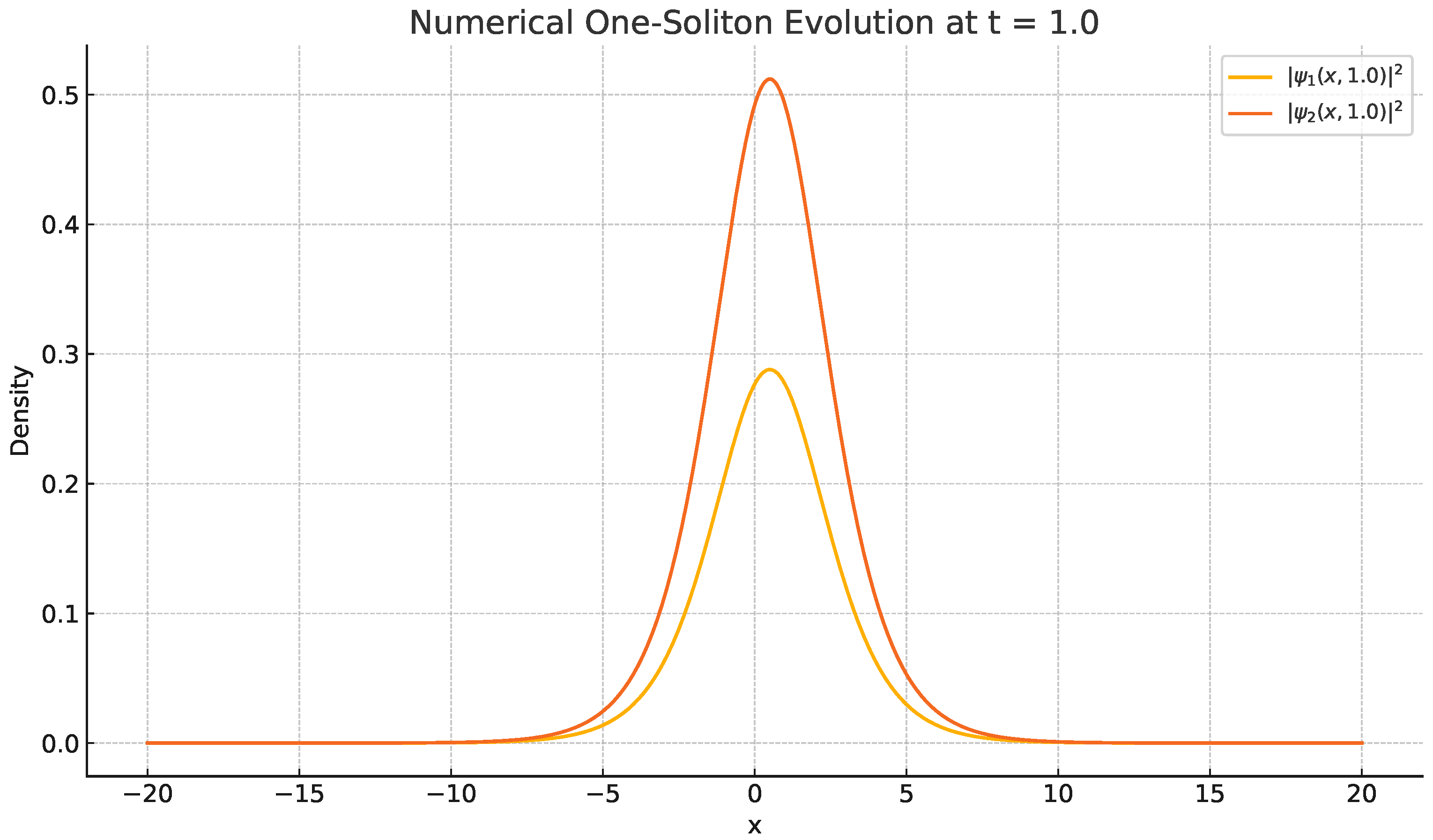
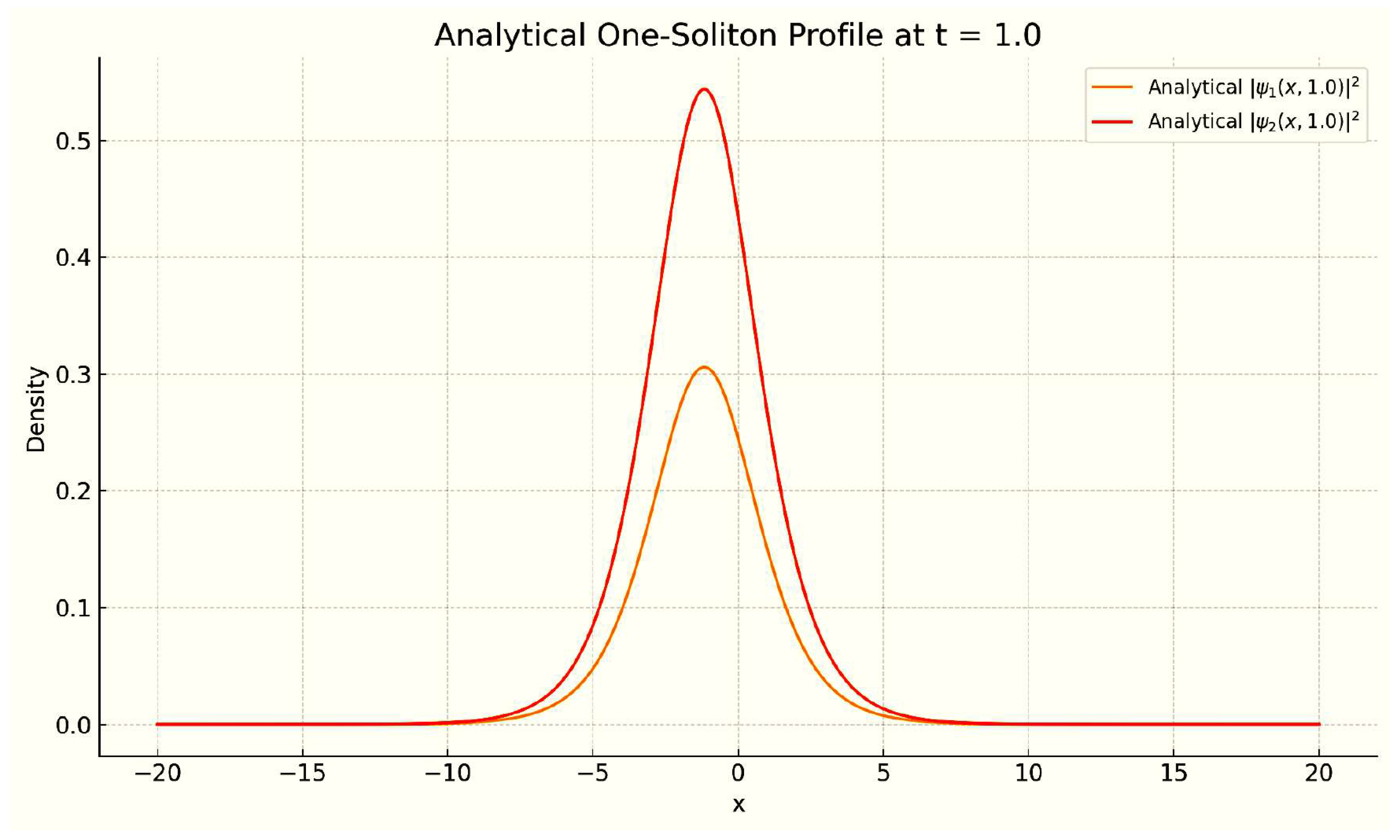
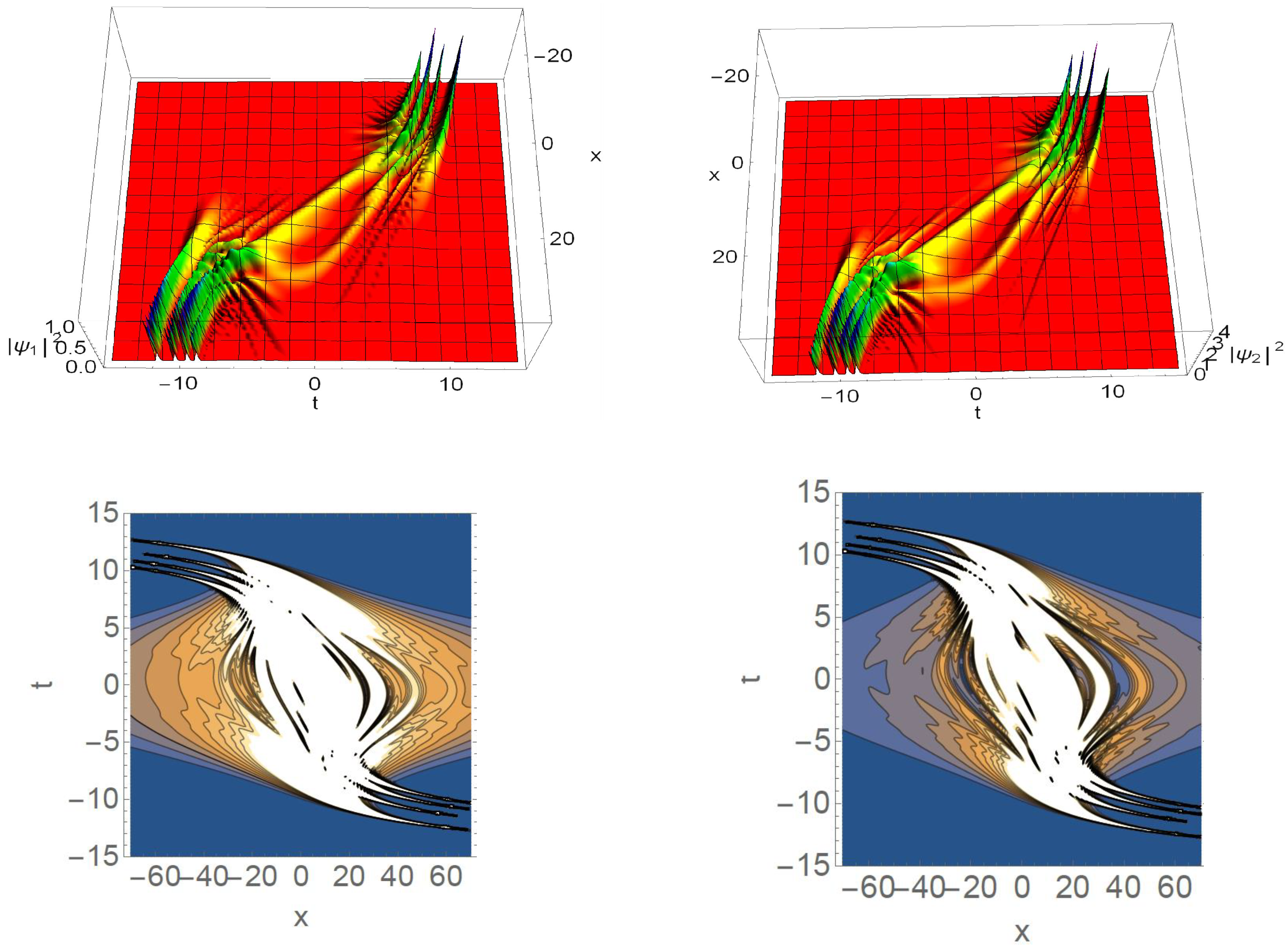
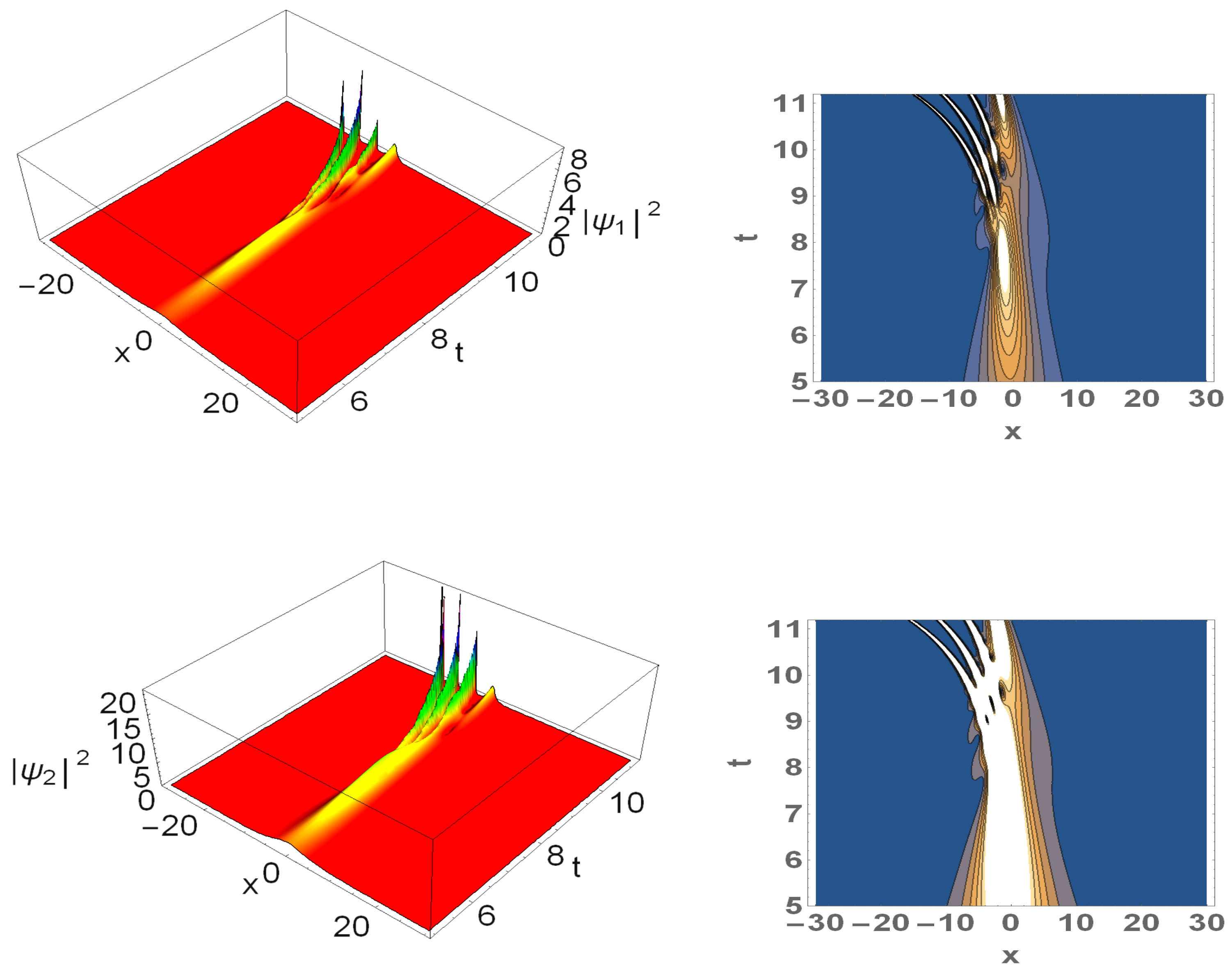

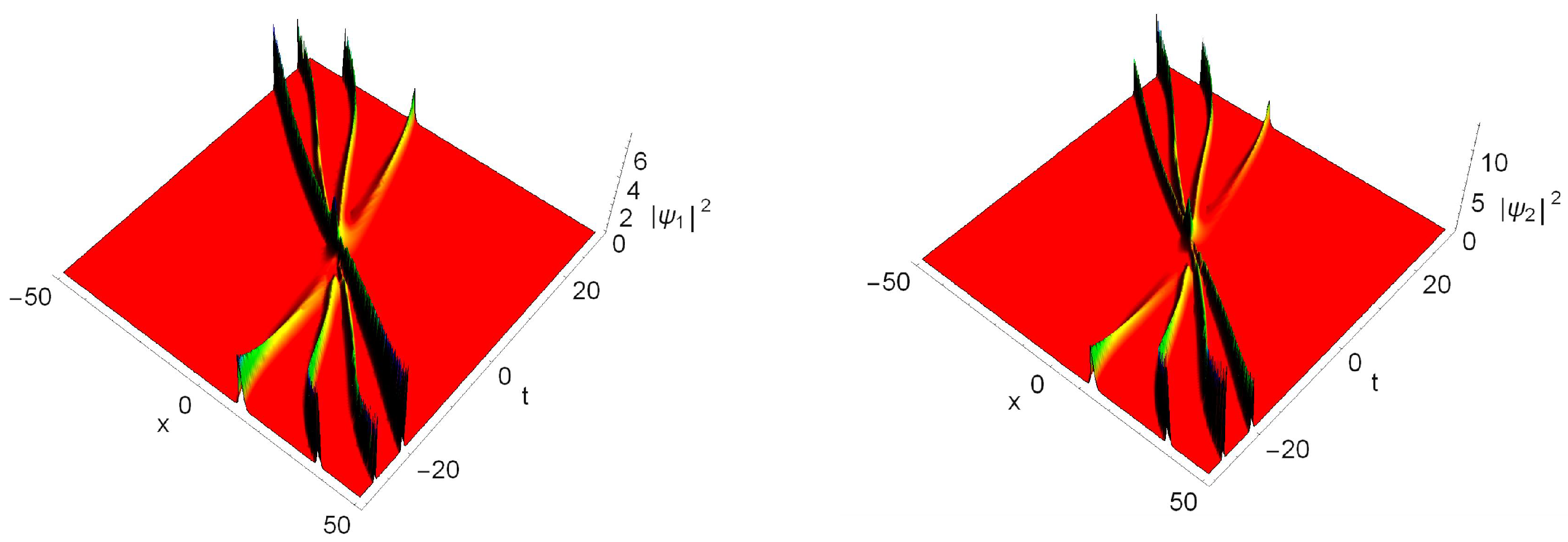
Disclaimer/Publisher’s Note: The statements, opinions and data contained in all publications are solely those of the individual author(s) and contributor(s) and not of MDPI and/or the editor(s). MDPI and/or the editor(s) disclaim responsibility for any injury to people or property resulting from any ideas, methods, instructions or products referred to in the content. |
© 2025 by the authors. Licensee MDPI, Basel, Switzerland. This article is an open access article distributed under the terms and conditions of the Creative Commons Attribution (CC BY) license (https://creativecommons.org/licenses/by/4.0/).
Share and Cite
Vaduganathan, R.K.; Vijayan, R.; Malomed, B.A. Controlled Fission and Superposition of Vector Solitons in an Integrable Model of Two-Component Bose–Einstein Condensates. Symmetry 2025, 17, 1189. https://doi.org/10.3390/sym17081189
Vaduganathan RK, Vijayan R, Malomed BA. Controlled Fission and Superposition of Vector Solitons in an Integrable Model of Two-Component Bose–Einstein Condensates. Symmetry. 2025; 17(8):1189. https://doi.org/10.3390/sym17081189
Chicago/Turabian StyleVaduganathan, Ramesh Kumar, Rajadurai Vijayan, and Boris A. Malomed. 2025. "Controlled Fission and Superposition of Vector Solitons in an Integrable Model of Two-Component Bose–Einstein Condensates" Symmetry 17, no. 8: 1189. https://doi.org/10.3390/sym17081189
APA StyleVaduganathan, R. K., Vijayan, R., & Malomed, B. A. (2025). Controlled Fission and Superposition of Vector Solitons in an Integrable Model of Two-Component Bose–Einstein Condensates. Symmetry, 17(8), 1189. https://doi.org/10.3390/sym17081189





